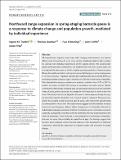Northward range expansion in spring-staging barnacle geese is a response to climate change and population growth, mediated by individual experience
Abstract
All long-distance migrants must cope with changing environments, but species differ greatly in how they do so. In some species, individuals might be able to adjust by learning from individual experiences and by copying others. This could greatly speed up the process of adjustment, but evidence from the wild is scarce. Here, we investigated the processes by which a rapidly growing population of barnacle geese (Branta leucopsis) responded to strong environmental changes on spring-staging areas in Norway. One area, Helgeland, has been the traditional site. Since the mid-1990s, an increasing number of geese stage in another area 250 km further north, Vesterålen. We collected data on goose numbers and weather conditions from 1975 to 2017 to explore the extent to which the increase in population size and a warmer climate contributed to this change in staging area use. During the study period, the estimated onset of grass growth advanced on average by 0.54 days/year in each of the two areas. The total production of digestible biomass for barnacle geese during the staging period increased in Vesterålen but remained stable in Helgeland. The goose population has doubled in size during the past 25 years, with most of the growth being accommodated in Vesterålen. The observations suggest that this dramatic increase would not have happened without higher temperatures in Vesterålen. Records of individually marked geese indicate that from the initial years of colonization onwards, especially young geese tended to switch to Vesterålen, thereby predominating in the flocks at Vesterålen. Older birds had a lower probability of switching to Vesterålen, but over the years, the probability increased for all ages. Our findings suggest that barnacle geese integrate socially learned behaviour with adjustments to individual experiences, allowing the population to respond rapidly and accurately to global change.
Citation
Tombre , I M , Oudman , T , Shimmings , P , Griffin , L & Prop , J 2019 , ' Northward range expansion in spring-staging barnacle geese is a response to climate change and population growth, mediated by individual experience ' , Global Change Biology , vol. Early View . https://doi.org/10.1111/gcb.14793
Publication
Global Change Biology
Status
Peer reviewed
ISSN
1354-1013Type
Journal article
Description
The study was funded by the Norwegian Environment Agency, the Research Council of Norway (the projects ‘LANDRING 134716/720’, ‘AGRIGOOSE 165836’, ‘MIGRAPOP 204342’), the European Union (the project FRAGILE EVK2‐2001‐00235), the County Governor of Nordland, the Wildfowl and Wetlands Trust, the Fram Centre in Tromsø and a grant from the Netherlands Organization for Scientific Research awarded to TO (ref 019.172EN.011).Collections
Items in the St Andrews Research Repository are protected by copyright, with all rights reserved, unless otherwise indicated.

